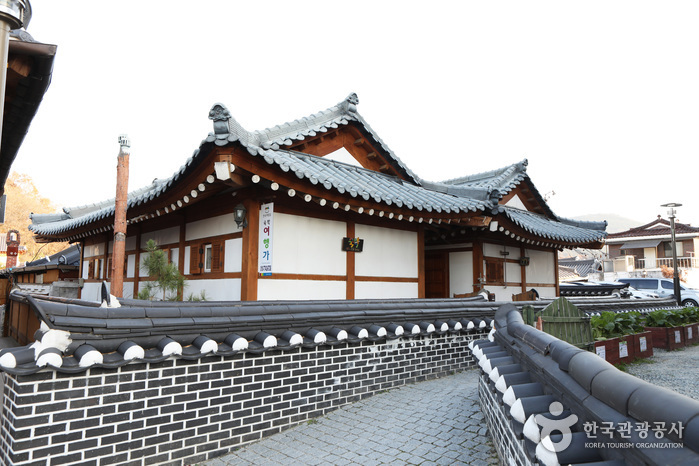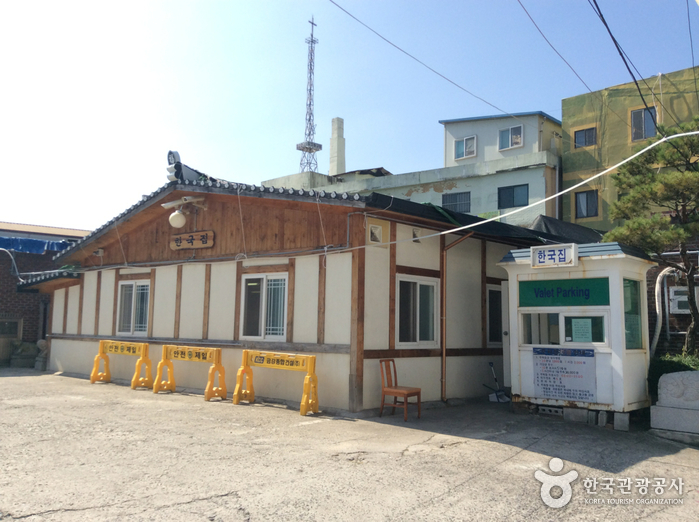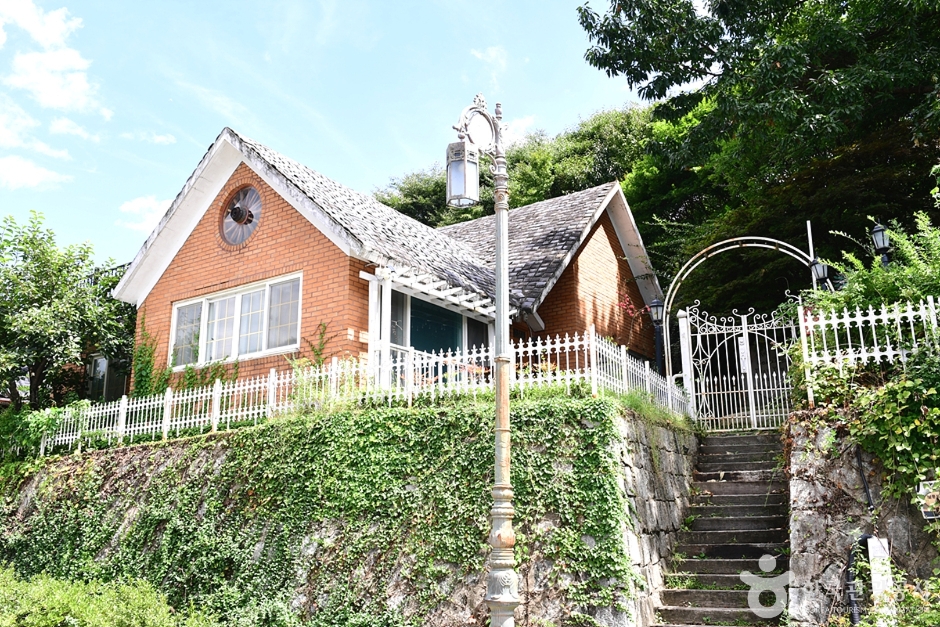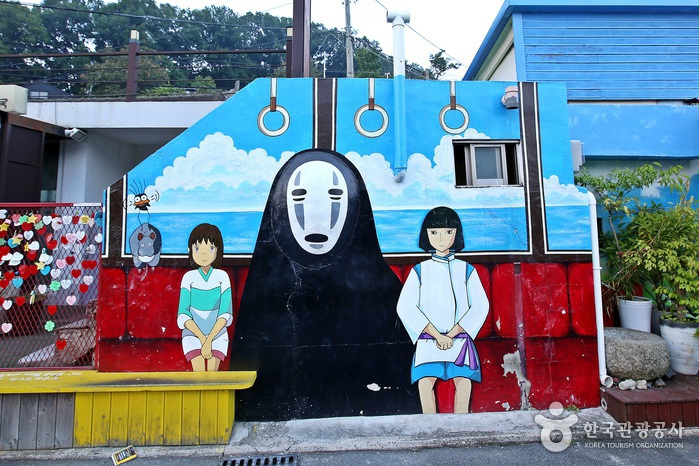Veteran Kalguksu (베테랑칼국수)
421.3M 2025-07-10
135, Gyeonggijeon-gil, Wansan-gu, Jeonju-si, Jeonbuk
Il s’agit d’un restaurant de nouilles traditionnelles aimé des habitants de Jeonju Hanok Village depuis plus de 40 ans, ouvert en 1977. L’établissement est réputé pour son bouillon épais et onctueux, mijoté longtemps, auquel sont ajoutés du perilla (sésame sauvage), de la viande et des œufs.
Les nouilles utilisées ne sont pas les larges nouilles ordinaires, mais des nouilles fines à la texture ferme et élastique. Le plat est garni de poudre de perilla, de piment et d’algues séchées, offrant un goût et une présentation constants au fil des années.
Outre les kalguksu (nouilles coupées au couteau), le restaurant propose des nouilles froides au soja (kongguksu) au goût riche et onctueux, ainsi que des mandu (raviolis) généreusement garnis, qui accompagnent parfaitement les nouilles. Avec chaque commande, du danmuji (radis mariné jaune) et du kimchi de radis en dés (kkakdugi) sont servis ; ce dernier est préparé maison avec des radis d’hiver de Jeju, ce qui lui confère un goût encore meilleur.
◎ Informations sur la Hallyu : ce restaurant est l’un des établissements fréquentés par les acteurs du drama Vingt-cinq, vingt et un. L’actrice principale, Kim Tae-ri, y est venue pour son petit-déjeuner lors du tournage de son vlog, attirant l’attention en dégustant son bol sans en laisser une seule nouille. Tout près se trouve aussi "2521 Guesthouse", la maison d’hôte ayant servi de résidence à Hee-do dans le drama, qui vaut une visite après le repas.
Yeohangga / 여행가
430.5M 2025-08-12
74-11, Eunhaeng-ro, Wansan-gu, Jeonju-si, Région Jeonbuk
+82-63-231-3040, +82-10-7742-6738
Yeohangga is a guesthouse owned and run by a woman who majored in early childhood education and who has been teaching children for over 20 years. The name means "A home for a happy trip," she says. It’s a unique guesthouse since the owner offers various traditional educational games. The cozy and comfortable guesthouse is a traditional Korean house built in March 2013 at a site where an old house used to be. The main building and detached building are divided by the ridge of the roof with beautiful rafters. There is another meaning to the name of the guesthouse: "a house where the woman is happy." She named it as such for a good reason. She used to live in Seoul when her parents advised her to move to Jeonju and run a guesthouse, leaving her husband and child behind. At first, she considered accepting only female guests, but it wasn't an option since most of the people visiting Jeonju are couples and groups of friends. Instead, she made sure the guesthouse is safe for women while building the house. Many female tourists traveling alone find this a great feature of the guesthouse because they feel safer during their stay. For one, she installed three doors for the rooms (1 transparent door, 1 opaque glass door, and a traditional Korean door). Not only do the guests feel safer; the rooms are also well-insulated thanks to the triple doors. The floors and walls are covered with traditional Korean paper coated with soybean oil, which is very environment-friendly. In the four rooms named “Spring,” “Summer,” “Autumn,” and “Winter,” there are many toys and materials for traditional Korean cognition games, such as “Chilgyo Game,” “Gonu Game,” and “Mabangjin.” It’s very likely that even Koreans have never heard of these games. The owner of the guesthouse chose these games specifically because they are perfect for children to play in a traditional Korean house. She teaches her little guests how to play the games. “Chilgyo Game” involves making a shape with 7 to 20 pieces, whereas “Gonu Game” is similar to the game of Chinese chess. "Mabangjin" is a type of IQ game that involves laying down a total of nine different numbers in three rows and columns so that the sum of the three numbers is identical when added horizontally, vertically, or diagonally. Many guests find these games interesting, and the owner of the guesthouse finds joy in teaching these games to as many families as possible. She recently took over another traditional Korean guesthouse called "Samrakheon" near the Jeonju Oriental Medicine Center. It's a stand-alone guesthouse for groups and families, and she uses the place to teach traditional games to more people.
Yangsajae [Korea Quality] / 문화공간 양사재 [한국관광 품질인증]
437.6M 2025-12-04
40, Omokdae-gil, Wansan-gu, Jeonju-si, Région Jeonbuk
+82-63-282-4959
L'Espace culturel Yangsajae se situe dans le village traditionnel de Hanok, à Gyo-dong Pungnam-dong, Jeonju. Ancien bâtiment annexe du hyanggyo, il servait autrefois de lieu d'étude pour les lettrés de l'époque Joseon. En franchissant le portail, on découvre la tranquillité de la cour avant. Il est possible d'y allumer le feu dans l'âtre du gudeulbang, et le site est apprécié pour la beauté de ses paysages nocturnes.
Hankookjib (한국집)
453.4M 2024-04-07
119, Eojin-gil, Wansan-gu, Jeonju-si, Région Jeonbuk
+82-63-284-0086, 2224
Hankookjib literally means 'Korean house.' The restaurant serves Jeonju bibimbap, kongnamul haejangguk (spicy bean sprout soup), sagol gomtang (thick beef bone soup), doenjang jjigae (soybean paste stew), and samgyetang (ginseng chicken soup). Many well-known figures, including former presidents of Korea, have been sited as enjoying the authentic Jeonju bibimbap here.
Maison 2521, prononcée « i-o-i-il » (이오이일)
465.0M 2025-08-12
5-19, rue Omokdae, Wansan-gu, Jeonju, province autonome spéciale de Jeonbuk (Gyodong)
2521 est un hébergement indépendant situé au cœur du village hanok de Jeonju. Il s’agit également de la maison du personnage principal Na Hee-do dans le drama Vingt-cinq, vingt-et-un. Lors de la réservation, le propriétaire peut installer des accessoires identiques à ceux utilisés dans la série.
Les clients peuvent profiter d’un barbecue dans la cour et admirer la vue panoramique du village hanok depuis la terrasse sur le toit. L’hébergement peut accueillir jusqu’à huit personnes.
Village des peintures murales de Jaman (자만벽화마을 - 외국어사이트용)
483.5M 2024-04-07
1-10, Jamandong 1-gil, Wansan-gu, Jeonju-si, Région Jeonbuk
Le village des peintures murales de Jaman est un petit village situé en face du village hanok de Jeonju, sur la colline d’une montagne. On peut trouver des maisons alignées les unes aux autres sur les pentes du village, sur les murs on trouve des peintures de toutes les couleurs.
Le village des peintures murales Jaman (자만마을 벽화갤러리)
483.8M 2025-08-12
Gyodong, Wansan-gu, Jeonju-si, Jeonbuk
Le village des peintures murales de Jaman se trouve sur une colline paisible, séparée du village traditionnel de Hanok de Jeonju par une simple route. Niché au pied du mont Seungamsan, ce quartier était à l’origine un bidonville formé progressivement par des réfugiés de la guerre de Corée.
C’est en 2012, dans le cadre d’un projet de sentier vert, qu’il a commencé à se transformer : des fresques ont été peintes sur une quarantaine de maisons, donnant au lieu une toute nouvelle identité. Aujourd’hui, chaque ruelle dévoile une série de peintures aux styles variés — fleurs, contes, paysages — offrant aux visiteurs une promenade aussi visuelle que divertissante.
Au fil de la balade, on découvre le Geumpyo de Jaman-dong, une stèle marquant l’emplacement de la maison de Yi An-sa, ancêtre du roi Taejo, fondateur de la dynastie Joseon. En montant un peu, on accède également au jardin sur le toit, un belvédère apprécié pour sa vue dégagée sur la ville de Jeonju sous un ciel bleu éclatant.
Le quartier abrite aussi de charmants cafés, des maisons d’hôtes et quelques restaurants, ce qui en fait une halte idéale pour les voyageurs. La visite complète prend environ 30 minutes. Proche des sites historiques d’Omokdae et d’Imokdae, le village est souvent intégré à des circuits culturels appréciés.
Cathédrale Jeondong (전주전동성당)
552.2M 2025-08-12
51, Taejo-ro, Wansan-gu, Jeonju-si, Région Jeonbuk
L’église catholique Jeondong de Jeonju a été érigée sur un site historique où, à l’époque de la dynastie Joseon, de nombreux catholiques furent martyrisés. Elle se situe à l’extérieur de la porte Pungnammun, dans le quartier de Jeondong à Jeonju, à l’emplacement même où des fidèles furent exécutés.
Comme Jeonju abritait le siège administratif provincial du Jeolla, Jeondong devint naturellement l’un des hauts lieux du martyre dans l’histoire du catholicisme coréen.
En 1791 (15ᵉ année du règne du roi Jeongjo), les premiers martyrs, Yun Ji-chung (Paul) et Kwon Sang-yeon (Jacques), furent exécutés ici, suivis en 1801 (1ʳᵉ année du règne du roi Sunjo) par Yu Hang-geon (Augustin), premier apôtre de la région de Honam, et Yun Ji-heon (François). Lors de la persécution de 1801, Yu Hang-geon et son frère Yu Gwan-geon furent écartelés, tandis que Yun Ji-heon, Kim Yu-san et Lee U-jip furent pendus.
Afin d’honorer leur mémoire, le père français Baudenet acheta le terrain en 1891 (28ᵉ année du règne du roi Gojong) et entreprit la construction de l’église en 1908. Elle fut achevée en 1914, sur la base des plans du père Poinel, architecte de la cathédrale Myeongdong à Séoul. Construite à l’époque de l’occupation japonaise, elle fut terminée après 23 ans de travaux.
L’édifice, en briques grises et rouges, rappelle la cathédrale Myeongdong et est considéré comme l’une des plus belles églises catholiques anciennes du pays. De style roman avec des éléments byzantins, c’est aussi l’une des plus belles réalisations architecturales de Corée. Initialement bâtie à l’extérieur de la porte Pungnammun, sur le lieu du martyre, elle fut ensuite agrandie à son emplacement actuel.
Première église de style roman construite dans la région de Honam, elle présente un plan rectangulaire et des murs extérieurs en briques, avec trois clochers byzantins – un central et deux latéraux. Le plafond intérieur est voûté en arc, et les allées latérales sont surmontées d’arcs croisés formant un motif en croix.
Certaines briques utilisées proviennent de la démolition de la forteresse de Jeonju ordonnée par le gouvernement japonais, les pierres de fondation ayant été extraites du mur d’enceinte près de la porte Pungnammun.
Porte Pungnammun (전주 풍남문)
554.9M 2024-04-08
1, Pungnammun3(sam)-gil, Wansan-gu, Jeonju-si, Région Jeonbuk
+82-63-287-6008
La porte Pungnammun a été construite dans le milieu du royaume de Jeoson (1768) et désignée trésor national no 308. Des 4 portes originales, c’est la seule qui reste (dans la partie sud de la ville). Sa structure a été partiellement détruite lors de l’invasion des forces étrangères de 1592 à 1598. Et a été reconstruite en 1978. Jungcheung et mullu sont au centre de la porte, épousant la forme de l’arche. Ces formes particulières forment le symbole du potentiel protecteur de la porte Pungnammun tout comme ils forment le symbole de sa grandeur.
Hakindang / 학인당
565.5M 2025-08-12
45, Hyanggyo-gil, Wansan-gu, Jeonju-si, Région Jeonbuk
+82-63-284-9929
Hagindang was built by the same master builder and carpenter who took part in building the palaces. It's the oldest traditional Korean house in Jeonju Hanok Village and a city/province-designated Folklore Heritage No. 8 situated in Hyanggyo-gil. It has a tall gate in the middle of high walls on either side, behind which are a large front yard with a pond as well as trees surrounding the pond. The house behind this pond is in perfect harmony with the landscape. Right next to the tall gate are a detached building called “sarangchae” and an area designated for experiencing Korean tradition, including another detached building called “byeoldangchae” behind the main building named “Hagindang.” Bonchaedaegwan, which consists of three rooms named “Baekbeomjisil,” “Haegongjisil,” and “Injaejisil” exude elegance and grace The “sarangchae” is a stand-alone building with two rooms with an open living room called "daecheong" in between, making it a perfect place for an entire family to stay. The "byeoldangchae" has a total of three rooms, and the first one (Room No. 1) has a tea room with three windows made of thin wooden frames on three sides. Hagindang serves traditional Korean breakfast like the head family.


![Yangsajae [Korea Quality] / 문화공간 양사재 [한국관광 품질인증]](http://tong.visitkorea.or.kr/cms/resource/75/1879875_image2_1.jpg)





 Français
Français
 한국어
한국어 English
English 日本語
日本語 中文(简体)
中文(简体) Deutsch
Deutsch Español
Español Русский
Русский